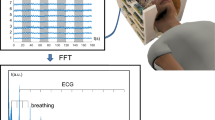Low-temperature superconductivity plays an important role in some specific biomedical applications, and, in particular, in non-invasive imaging methods of human brain activity. Superconducting magnets are indispensable for functional magnetic resonance imaging (fMRI) which allows functional imaging of the brain with high spatial but poor temporal resolution. Superconducting quantum interference devices (SQUIDs) are the most sensitive magnetic field detectors. Up to a few hundreds of SQUIDs are nowdays used in modern whole-head magnetoencephalography (MEG) systems. They allow tracking brain activation with a superior temporal resolution of milliseconds, which is a quintessential condition for the monitoring of brain dynamics and the understanding of information processing in the human brain. We introduce the prerequisites of MEG data acquisition and briefly review two established methods of biomagnetic signal processing: The concept of signal averaging, and the subsequent source identification as a solution of the biomagnetic inverse problem. Beside these standard techniques, we discuss advanced methods for signal processing in MEG, which take into account the frequency content of the recorded signal. We briefly refer to the prospects of Fourier analysis and wavelet transform in MEG data analysis, and suggest matching pursuit as a promising tool for signal decomposition and reconstruction with high resolution in time-frequency plane.
Similar content being viewed by others
References
Bednorz J.G., Müller K.A., (1986). Zeitschrift für Physik B 64, 189
Lauterbur P.C.,(1973). Nature 242, 190
Mansfield P., Maudsley A.A., (1977). J. Mag. Resonan. 27, 101
Hämäläinen M., Hari R., Ilmoniemi R.J., Knuutila J., Lounasmaa O.V., (1993). Rev. Modern Phys. 65, 413
Jezzard P., Matthews P.M., Smith S.M., Functional MRI. An introduction to methods, Oxford University Press. 2001.
Buxton R.B., Introduction to functional magnetic resonance imaging, Cambridge University Press. 2002.
Z.-L. Lu and L. Kaufman, Magnetic source imaging of the human brain, Lawrence Erlbaum Associates. 2003.
J. Vrba, in ed. Applications of superconductivity H.Weinstock (Dordrecht, The Netherlands: Kluwer Academic, 2000).
Wikswo J.P. Jr, (1995). IEEE Trans. Appl. Supercond. 5, 74
Vrba J., Robinson S.E., (2001). Methods 25, 249
Uusitalo M., Ilmoniemi R., (1997). Med. Biol Eng. Comput. 35, 135
S. Taulu and M. Kajola, J. Appl. Phys. 97, 124905.0–10, (2005).
Näätänen R., Picton T., (1987). Psychophysiology 24, 375
von Helmholtz H., (1853). Annalen der Physik und Chemie 89, 211–353
Sarvas J., (1987). Phys. Med. Biol. 32, 11
M. Scherg, in eds. Evoked Magnetic Fields and Electric Potentials, volume 6 of Advances in Audiology, F. Grandori, M. Hoke, and Romani G.L. (Karger, Basel, 1990).
Mosher J.C., Lewis P.S., Leahy R.M., (1992). IEEE Trans. Biomed. Eng. 39, 541
Mosher J.C., Leahy R.M., (1999). IEEE Tans. Signal Process. 47, 332
Michel C.M., Murray M.M., Lantz G., Gonzalez S., Spinelli L., Grave dePeralta R., (2004). Clin. Neurophys. 115: 2195
Dawson G.D., (1954). Electroen. Clin. Neuro. 6, 65
Truccolo W., Ding M., Knuth K., Nakamura R., Bressler S., (2002). Clin. Neurophys. 113, 206
deMunck J.C., Bijma F., Gaura P., Sielużycki C.A., Branco M.I., Heethaar R.M., (2004). IEEE Trans. Biomed. Eng. 51(12): 2123
S. Mallat, A wavelet tour of signal processing, Academic Press, New York, second edition. 1999.
W.J. Williams, in ed. Time frequency and wavelets in biomedical signal processing, IEEE Press Series in Biomedical Engineering, M. Akay, (IEEE press, New Jersey, 1997).
Mallat S., Zhang Z., (1993). IEEE Trans. Signal Process. 41: 3397
Durka P.J., Ircha D., Blinowska K.J., (2001). IEEE Trans. Signal Process. 49(3): 507
P.J. Durka and K.J. Blinowska, in ed. Time frequency and wavelets in biomedical signal processing, IEEE Press Series in Biomedical Engineering, M. Akay, (IEEE press, New Jersey, 1997).
żygierewicz J., Blinowska K.J., Durka P.J., Szelenberger W., Niemcewicz Sz., Androsiuk W., (1999). Clin. Neurophys. 110(12): 2136
Durka P.J., Ircha D., Neuper Ch., Pfurtscheller G., (2001). Med. Biol. Eng. Comp. 39(3): 315
Jouny C.C., Franaszczuk P.J., Bergey G.K., (2003). Clin. Neurophys., 114, 426
Durka P.J., Matysiak A., Montes E.M., Valdés Sosa P., Blinowska K.J., (2005). J. Neurosci. Method. 148(1): 49
Matysiak A., Durka P.J., Montes E.M., Barwiński M., Zwoliński P., Roszkowski M., Blinowska K.J., (2005). Acta Neurobiol. Exp. 65, 435
Author information
Authors and Affiliations
Corresponding author
Rights and permissions
About this article
Cite this article
König, R., Sielużycki, C. & Durka, P.J. Tiny Signals from the Human Brain: Acquisition and Processing of Biomagnetic Fields in Magnetoencephalography. J Low Temp Phys 146, 697–718 (2007). https://doi.org/10.1007/s10909-006-9290-9
Published:
Issue Date:
DOI: https://doi.org/10.1007/s10909-006-9290-9




